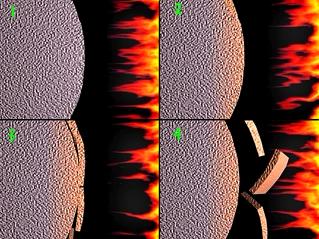Many cations or anions are soluble in water. As water passes through the channels and fractures in the ground it may dissolve this material. When the water solution becomes saturated (saturated: the maximum amount of a dissolved substance a liquid can contain at a given temperature and pressure) it will begin to precipitate the salt.
This salt coming out of solution may exert forces on adjacent crystal surfaces or along fracture lines which are sufficient to create new fractures or enlarge existing ones.
The dissolution of the salt is actually a form of chemical weather discussed in the next few pages, but the recrystallization and resultant forces are examples of physical weathering.
Rock in general is a good insulating material. It takes time for heat to penetrate the outer layers and reach equilibrium throughout its mass.
If the composition of the rock has minerals in it that have strongly different thermal expansion and contraction, then external heating may be sufficient to cause spalling. Spalling occurs when a rock is subjected to high rapid heating, and the outer most surface tries to expand quickly, while layers below are not yet affected by the heat and refuse to expand.
Effectively the outer surface tries to expand while the interior tries to maintain its original size. The outer surface may then fracture and fall away.

| NEXT | TOC | PREV |